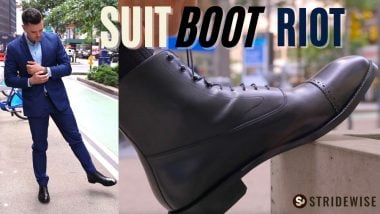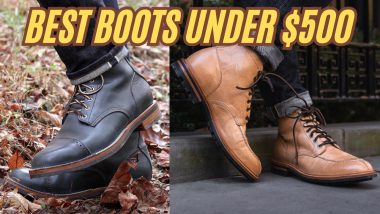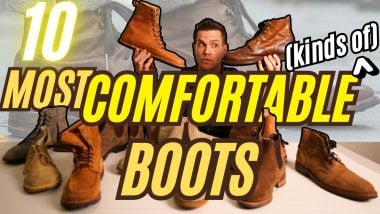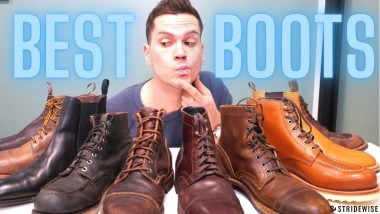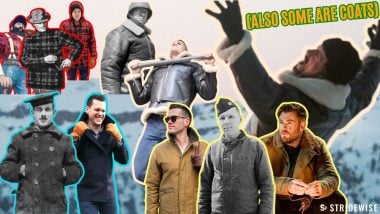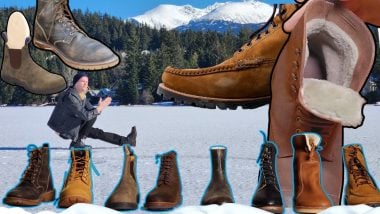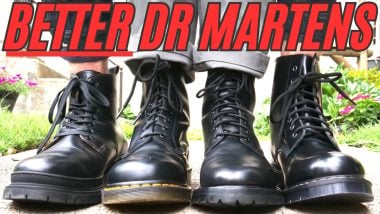Best British Boots: Northampton’s Finest Footwear Reviewed
On a recent trip to visit my sister in England, I was joined two very special guests, Diego from Urban Lad and Tom from Kudusole, to talk about the British boots. Both of these gentlemen run excellent YouTube channels dedicated to
OK, I’m not saying this is all of the best British boots, there are some brands we didn’t have, most notably the ultra fancy bespoke maker John Lobb, but we had enough boots to do a list of very good British boot brands you should know about.
We met at Diego’s place, which is perfectly located in Northampton, the heartland of British shoemaking where every one of our boots was made.
British vs. American Boots: What is the difference?
- Heritage: British boots tend to have origins for farming or hunting, while American boots tend to have origins in manual labor and outdoor work.
- Style: British boots tend to emphasize versatility and brogue details, whereas American boots tend to be built for more punishing wear.
- Finishing and quality: American boots are usually built for durability, British boots are usually built for versatility, with a greater focus on finishing.
“You can often identify a British boot from a mile away,” says Tom. “It’s a distinct aesthetic and a completely different approach to boot design.”
For most British brands we looked at, there’s a strong undercurrent of the classic British country style. This often gets contrasted with what’s generally termed American heritage style or vintage workwear style.
American boots, broadly speaking, often evoke images of boots worn to tame and settle the New World: think Midwestern work boots, like the Red Wing Iron Ranger, or perhaps rugged logging boots like those from Nicks.

British boots are often described as “country style” boots. They’re a bit less work-focused than many American styles but are still decidedly outdoorsy — the way we put it is they’re more outdoorsy and less work-y. Their ancestry lies more in trudging through the countryside for activities like farming or hunting rather than building a new country.
British boots are typically more versatile as well: designed to be relatively acceptable both indoors and outdoors.
“That’s the difference,” says Diego. “You can wear British boots in the town or you can wear them in the countryside, and it’s gonna be fantastic. You can wear them with a suit or with jeans. That’s the philosophy behind this style of boot.”
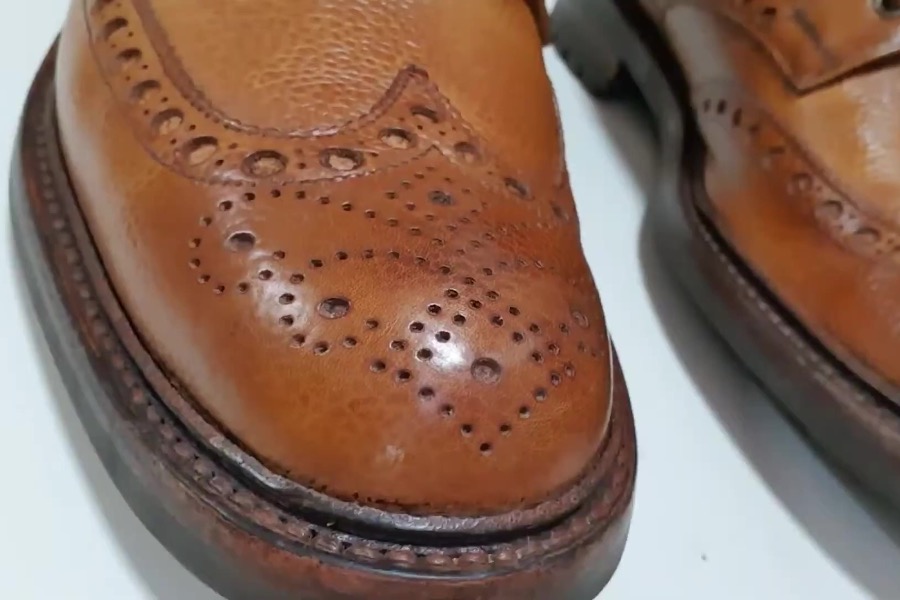
Broguing on British Boots
Country style shoes often feature broguing, which refers to the decorative perforations.
Originally, the point of broguing was to help water drain from the boots when walking through wet terrain. Today, broguing is largely ornamental and often seen as a sign that a boot is dressier — it’s funny to think that a hundred years ago, broguing was an unmistakeable sign that your footwear was made for the outdoors, not for a suit!
“What I love is that each brand has a different pattern in their broguing,” says Tom. “Outsiders might just not differentiate between them, but each pattern is unique to the brand.”


Iconic British Boot Brands
We looked at a fantastic lineup of classic British brands, ranging from about USD600 to three times that amount. All the boots we had with us are 100% made in Northampton.
Note that we were missing a few important brands, most pertinently Loake, Church’s, and the high-end John Lobb.
But we had a good range of boots, starting with Cheaney.

Joseph Cheaney
- Heritage: Some of Cheaney’s earliest designs were for RAF pilots during World War II
- Fit & Construction: Quite wide in the toes, so you can comfortably wear thick socks.
- Welt & Protection: Most Cheaney boots have Goodyear welts, but some, like the Tweed have a storm Goodyear welt
- Brogue Details: Each brand often has a unique broguing pattern on the toe caps and uppers
“If you’re interested in British boots, I’d say Cheaneys are a very good entry point,” Tom says. “They’re cheaper than other boots you might like, so I’d recommend starting there and working your way up once you start collecting.”
A great entry point to British boots is Cheaney, founded by Joseph Cheaney in 1886, and now owned by the former proprietors of Church’s, another big name in British footwear. Reportedly, this change in ownership has reportedly led to significant improvements in the quality — a rare outcome of a buyout!

Cheaney’s history includes designing boots for RAF pilots in the Second World War, and they do a good job of continuing to produce historically significant boots for customers today.
“My Jarrow boots are a very old design that’s very wide on the toes, so it’s comfortable with thick socks,” says Diego.

“Another difference between English boots and American boots is that with US brands like White’s or others, the tongues are usually gusseted all the way to the top,” Tom says. “But the Jarrow aren’t gusseted. It makes them a little easier to break in, though, and I’d say they’re easier to wear.”
The boots are Goodyear welted, and Tom’s Tweed boots have a storm Goodyear welt, which is an extra water resistant kind of Goodyear welt — so they’re resoleable and practically waterproof.

Grenson
- Welt Construction: Goodyear welts, storm welts, and Veldtschoen available.
- Leather: Grenson doesn’t typically disclose their tannery, but it’s good quality cowhide.
“Grenson is a British shoemaker founded in 1866 in Northampton, England,” Tom explains. “William Green started it, and after he passed away, his sons took over the business and changed the name to Grenson. Like many other shoemakers in Northampton, the brand has over 150 years of history.”
Tom has two pairs of Grenson boots, the Fred (above) and the Vincent (below). Of all the boots we had on the table, the Vincent had a more American vibe, while the Fred looks as much a brogued British country boot as anything else we had.

“The Vincent from Grenson, the welt is actually quite different from the others. It’s similar to Pacific Northwest boots, actually, because the upper leather goes over the welt and sits on the outside,” Tom says. “It’s Veldtschoen construction, so while it’s not the same as stitchdown construction, like on a logger boot, but it’s not a Goodyear welt either. I would say it’s more rugged than the other boots we’re looking at here, but it’s still very comfortable.”
This veldtschoen construction has the upper stitched onto the welt, eliminating the gap between the upper and the sole and making it extra water resistant. Appropriately, veldtschoen translates literally as bush shoe.
Grenson’s most popular model is probably the ‘Fred,’ which is a brogued boot, or the ‘Archie,’ their brogued shoe. So, the Vincent is a bit of an outlier compared to their more classic offerings.
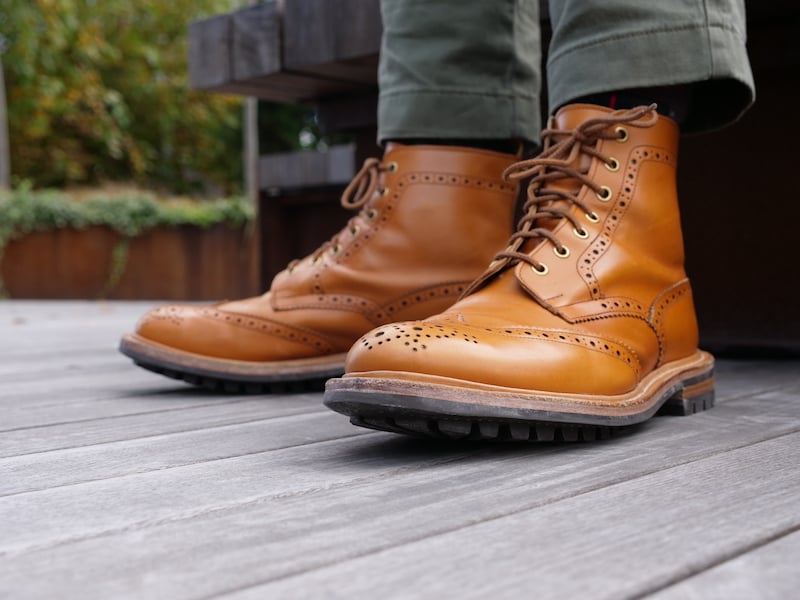
Tricker’s
- Style & Comfort: Tricker’s Stow is a classic brogued country boot.
- Some models can be more narrow: I found the monkey boot too narrow for me, but their classic models are nice and roomy.
- Design & Appeal: Boasting a Royal Warrant from King Charles, Tricker’s is among the country’s most respected shoemakers.
Britain’s oldest Goodyear welted shoe brand, Tricker’s is considered one of the nation’s greatest purveyors of fine footwear — they even have a Royal Warrant, a mark of recognition that their products are of sufficiently high quality to outfit members of the Royal family and their staff.
When I visited their store in London, they told me the Stow boot (~USD 780) comprises more than half of their sales. If you’re considering one, the golden leather called Acorn Antique is what they’re best known for. I also visited their factory in Northampton, check it out:
“I would say this is wider than other boot, because this is the country boot that they emphasize, and it’s very British country,” says Tom, who owns the Stow boot in brown suede. “I have wide feet, so I was happy to find they fit me very well.”
I (Nick, the host guy in the video) also own their Ethan monkey boots, which look a little like a fancy leather version of Converse Chuck Taylor sneakers. I’d say that these sleek and non-brogued boots are a great way to bridge American and British boots, but number one: I found them really narrow, and number two: they aren’t sold anymore. But they currently have these shorter versions that are like monkey chukkas.

Crockett & Jones
- Design and Appeal: Worn by British officers in World War II, and Daniel Craig wore the brand in all of his James Bond films.
- Popular Models: The Coniston (~USD850) is their most influential lace up boot, but they’re also known for their brogued Islay boot (~USD900) and chukkas (~USD700).
As we move up in price, we have Crockett & Jones, a brand that rivals Tricker’s for their influence and popularity. Their best known boot might be the relatively simple derby, the Coniston, but the brogued Islay is iconic in its own right.
“I was buying these boots in a shop in Cork, and an older guy came in with a pair that he’d resoled two or three times,” says Diego. “He had been wearing the same pair for decades, and they looked amazing.”
It’s said that Daniel Craig was already a fan of the brand and suggested that James Bond wear them in his films, launching a relationship between Bond and brand that was very beneficial for Crockett & Jones.
They tend to run large: Diego’s pair was a UK size 10, while his others are 10.5. Note that generally speaking, Americans want to size down half a size from their US boot size or a whole size from their Brannock size. I’m an 11.5 Brannock, a 12US in most sneakers, 11US in most US boots, 11UK in most British sneakers, and 10.5UK in most British boots. Apparently, I’d be a 10UK in Crockett & Jones.
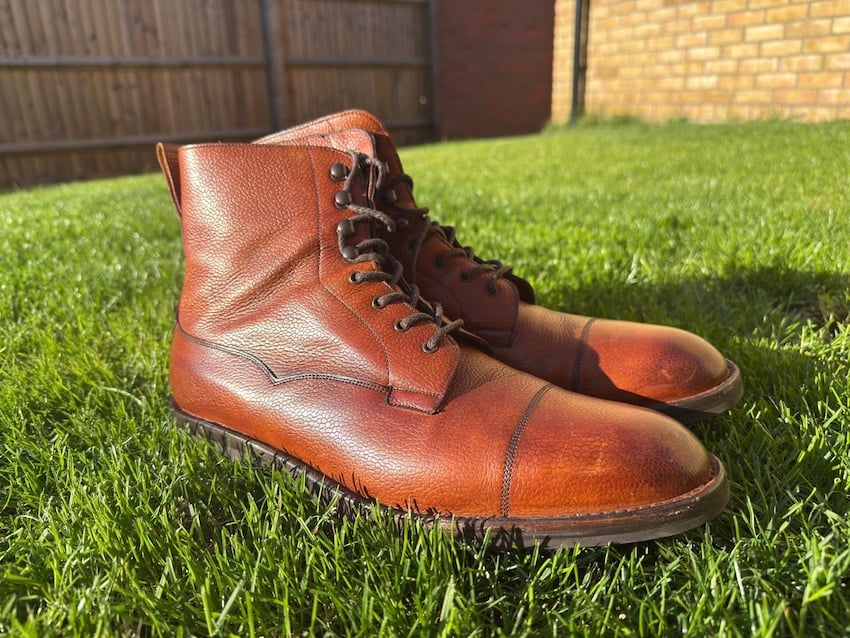
Edward Green
- Price Point: Their flagship boot, the Galway, costs around USD1,900
- Heritage: Edward Green’s Galway was designed specifically for the officers in the British army
- Construction: Various premium touches, like hand clicking and sewing with a boar hair instead of a needle
The most premium brand on our table was Edward Green, one that I knew was pricier than the others, but I didn’t realize it was three times the price of the Cheaney.
The Galway is a Derby boot with a horizontal seam dividing the upper that might bring to mind a Balmoral boot, but Balmorals are Oxfords and this is a derby. In other words, this isn’t a dress boot, despite its high price.
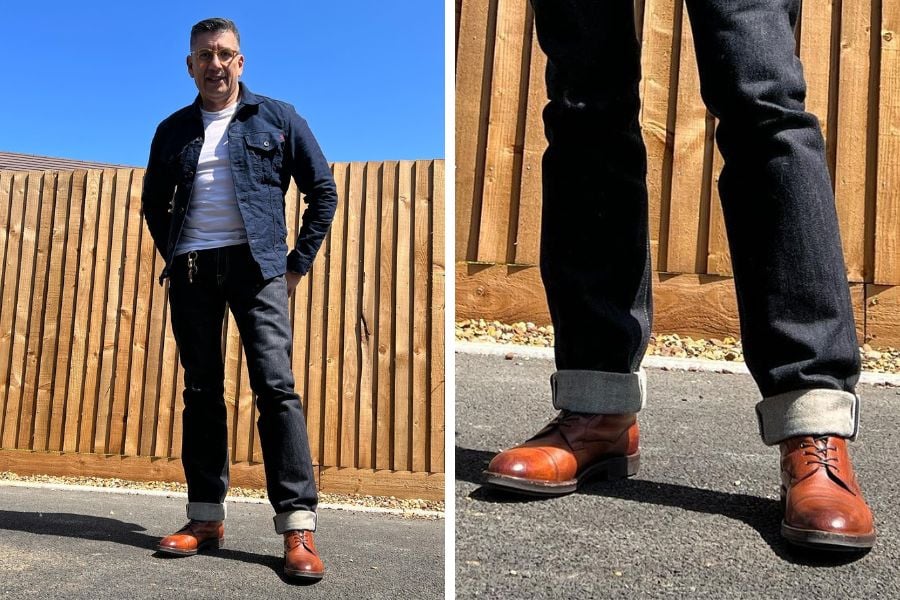
“I was lucky enough to tour the Edward Green factory, as it’s very close to where I live and work,” Diego says. “It’s a small factory, and it’s amazing to see how artisanal the process still is. The clicking is all done by hand, with no machines. Most of the leather is French calf from one of the top suppliers. The construction is incredible — really impressive.”
Friend-of-the-site Dave from the Vintage Future reviewed his boots for Stridewise, which you can read here. You can also watch his video above.
The man truly wore the heck out of his Galways and they look absolutely fantastic, despite (or because of) it. The Galway is an original design (that many brands have copied) that’s both very water resistant and very, very versatile.
Final Thoughts
So which British boot should you consider? At about £400, Tom thinks Cheaney is a very good entry point that allows you to experience a brand with a lot of heritage without such a massive initial investment.
Personally, I think if you’re going to get one British boot, it should be Tricker’s: it’s got the Royal Warrant, it’s right in the middle of this article’s price range, and they’ve got a clear hero product (the Stow in Acorn Antique) that will let you know you’re wearing What The Hype Is All About. They’re also just easier to buy in the US; I got mine at Division Road.
For more fantastic content on boots and menswear, especially focusing on British brands, be sure to subscribe to Diego’s channel, Urban Lad, and Tom’s channel, Kudusole.

